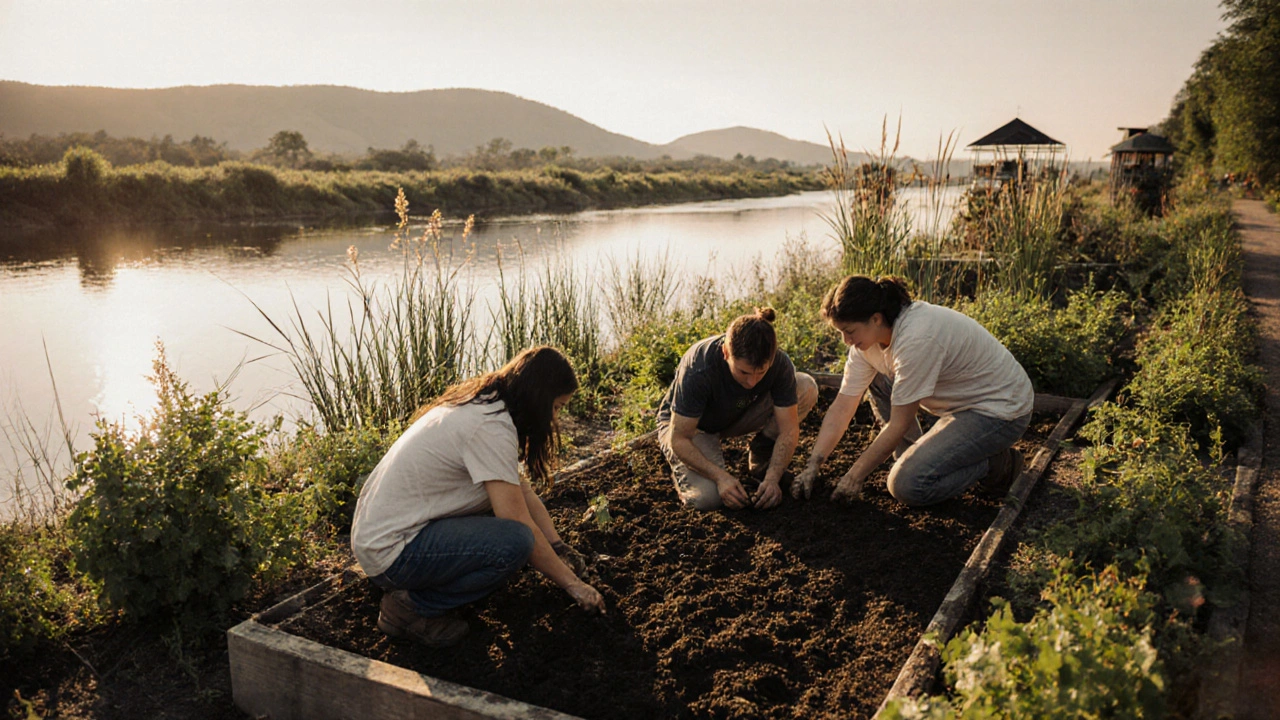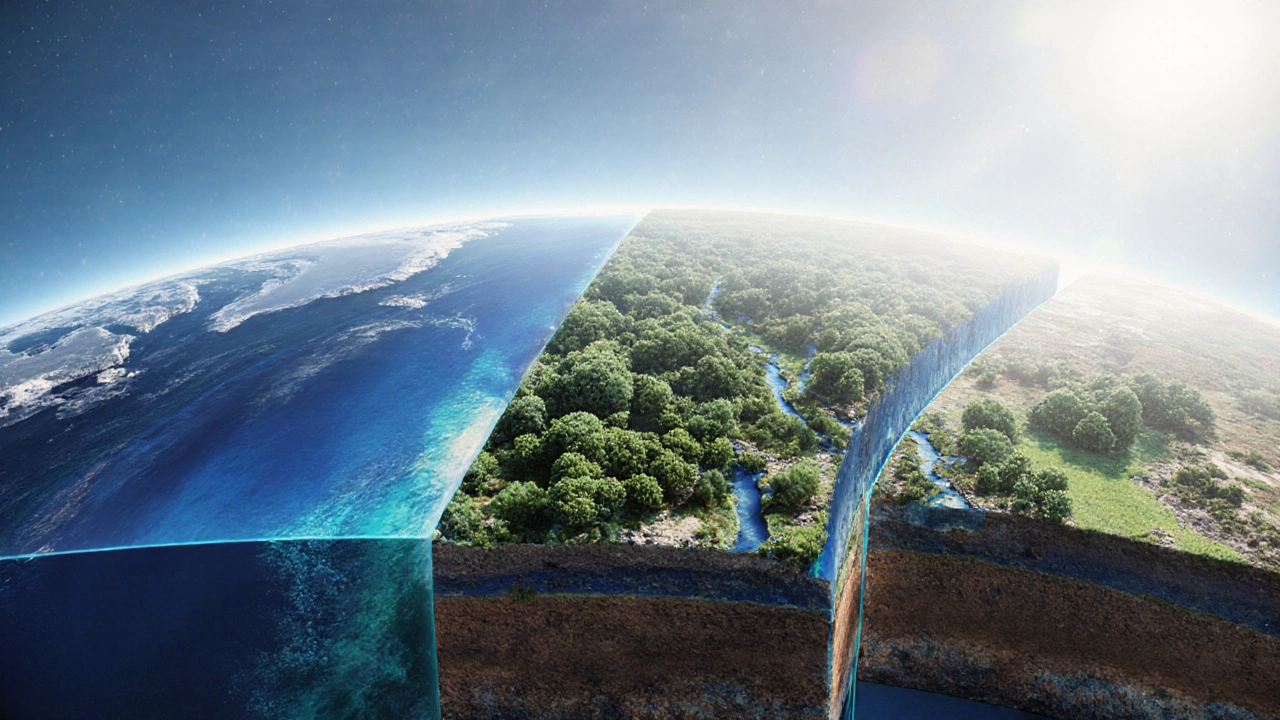Environmental Action Impact Checker
Check Your Environmental Action
Select an action from the list below to see which of the four environmental spheres it impacts. This tool helps community groups design holistic environmental projects.
Select an action to see which environmental spheres it impacts.
Why This Matters
By understanding how your environmental action impacts all four spheres (Atmosphere, Hydrosphere, Lithosphere, and Biosphere), you can design more effective projects that address multiple environmental challenges simultaneously.
When people talk about the "environment," they often imagine forests, oceans or city parks. In reality the Earth works as a set of four major environmental spheres that constantly exchange energy, water and matter. Knowing what each sphere does, how they link together, and why they matter to community groups can turn vague concern into concrete action.
What are the four major environmental spheres?
Scientists group the planet’s physical and living parts into four broad domains:
- Atmosphere - the layer of gases surrounding Earth, responsible for weather, climate and protecting life from harmful solar radiation.
- Hydrosphere - all water on the planet, from oceans and rivers to ground‑water and ice caps.
- Lithosphere - the solid outer shell, including rocks, soil and the mantle that forms continents and ocean basins.
- Biosphere - every living organism and the ecosystems they create, from microbes to forests and coral reefs.
These spheres aren’t isolated rooms; they overlap and feed into one another like pieces of a giant puzzle.
Atmosphere - The Air We Breathe
The atmosphere is a thin blanket of gases-mostly nitrogen (78%) and oxygen (21%)-that extends up to about 100 km. It does three big jobs:
- Regulating temperature through the greenhouse effect, which keeps the planet warm enough for liquid water.
- Transporting water in the form of clouds, rain and snow, driving the water cycle.
- Shielding life from ultraviolet (UV) radiation via the ozone layer.
Key processes include the carbon cycle (CO₂ exchange between plants, oceans and the air) and the nitrogen cycle (conversion of atmospheric N₂ into usable forms). When air quality drops-think smog in megacities-it directly harms human health and reduces crop yields.
Hydrosphere - All the Water
Water covers about 71% of Earth’s surface. The hydrosphere includes:
- Oceans, which store 97% of the planet’s water and act as a massive heat sink.
- Freshwater bodies-rivers, lakes, wetlands-used for drinking, agriculture and recreation.
- Groundwater, hidden in aquifers and feeding springs.
- Ice: glaciers, sea ice and polar ice caps, which reflect sunlight and influence sea level.
Through evaporation, condensation and precipitation, the hydrosphere fuels the water cycle, shaping weather patterns and providing the moisture needed for the biosphere. Pollution like plastic debris or nutrient runoff can trigger dead zones, where oxygen levels drop and fish can’t survive.
Lithosphere - The Solid Ground
The lithosphere is the outermost solid part of Earth, ranging from a few kilometres beneath the oceans to about 100 km under continents. It consists of:
- Bedrock and tectonic plates that move, causing earthquakes and volcanic eruptions.
- Soil layers-known as the pedosphere-that support plant growth.
- Mineral resources such as copper, lithium and rare earth elements, essential for modern technology.
Soil health is a key indicator of sustainable land use. When topsoil erodes due to over‑grazing or deforestation, the capacity to grow food plummets, leading to food insecurity and increased pressure on the other spheres.

Biosphere - Life Everywhere
The biosphere encompasses every living thing-from microscopic bacteria to towering redwoods-and the ecosystems they interact with. It is the only sphere that actively transforms energy: photosynthetic organisms capture sunlight, convert it into chemical energy, and pass it up the food chain.
Major functions include:
- Regulating atmospheric gases (plants absorb CO₂, animals emit CO₂).
- Stabilizing soils through root systems and organic matter.
- Filtering water, as wetlands trap sediments and nutrients.
Loss of biodiversity-for example, the decline of pollinators-weakens these feedback loops, making the whole planet more vulnerable to climate shocks.
How the Spheres Interact
Think of the four spheres as a set of hands passing a ball back and forth. A drop of rain (hydrosphere) evaporates, becomes vapor, and joins the atmosphere. The sun’s heat drives that evaporation, while wind moves the vapor across continents. When the vapor lands on a forest (biosphere), plants use it for photosynthesis, releasing oxygen back into the air. Meanwhile, roots break down rock (lithosphere) to release nutrients into the soil, which then dissolve in water and travel downstream.
Disruptions in one sphere ripple through the others. A major oil spill contaminates the hydrosphere, killing marine life (biosphere) and fouling coastlines (lithosphere). The loss of kelp forests reduces carbon sequestration, leaving more CO₂ in the atmosphere and accelerating warming.
Why Community Groups Should Care
Local volunteers, youth clubs, and charity organizations often focus on a single issue-like planting trees or cleaning rivers-but the biggest impact comes from recognizing the links between spheres. Here’s why the holistic view matters:
- Strategic planning: Projects that address soil health (lithosphere) also improve water retention (hydrosphere) and boost plant growth (biosphere).
- Funding opportunities: Grant bodies increasingly look for programs that demonstrate cross‑sphere benefits, such as “green infrastructure” that mitigates flooding while creating habitats.
- Advocacy power: When you can explain how cutting down wetlands harms both water quality and air‑borne pollutants, policymakers are more likely to listen.

Practical Steps for Action
Below is a quick‑start checklist for groups that want to make a difference across all four spheres.
| Sphere | Key Component | Primary Processes | Typical Community Actions |
|---|---|---|---|
| Atmosphere | Gases (N₂, O₂, CO₂) | Weather, climate regulation, gas exchange | Tree planting, air‑quality monitoring, renewable‑energy campaigns |
| Hydrosphere | Water (liquid, ice, vapor) | Water cycle, ocean currents, sediment transport | River clean‑ups, rain‑garden installations, plastic‑reduction drives |
| Lithosphere | Rocks, soil, minerals | Weathering, nutrient cycling, tectonic activity | Soil‑testing workshops, community gardens, erosion‑control plantings |
| Biosphere | Living organisms & ecosystems | Photosynthesis, food‑web dynamics, habitat formation | Habitat restoration, pollinator hotels, citizen‑science biodiversity surveys |
Pick one activity from each column and you’ll be hitting all four spheres in a single project. For example, a community garden planted on a riverbank restores soil (lithosphere), filters runoff (hydrosphere), provides habitat for insects (biosphere), and absorbs CO₂ (atmosphere).
Common Pitfalls and How to Avoid Them
- Focusing on a single sphere: A tree‑planting day is great, but if the soil is compacted the saplings may die. Pair planting with soil aeration.
- Ignoring local context: Coastal communities need salt‑tolerant plants; inland groups should prioritize water‑holding soil amendments.
- Overlooking measurement: Track progress with simple metrics-e.g., water quality test strips, soil pH meters, biodiversity counts-to prove impact and attract funders.
Mini‑FAQ
What exactly is the biosphere?
The biosphere includes every living organism on Earth plus the ecosystems they form. It interacts with air, water and soil to recycle nutrients and regulate climate.
How does the lithosphere affect climate?
Rocks and soils store carbon in the form of organic matter and minerals. When soils erode or are disturbed, stored carbon can be released as CO₂, adding to greenhouse gases.
Can a small community impact all four spheres?
Yes. A well‑planned project-like a rain‑garden beside a native‑plant meadow-improves water infiltration (hydrosphere), enriches soil (lithosphere), provides habitat (biosphere), and captures carbon (atmosphere).
Why is the atmosphere called a "blanket"?
Because its gases trap heat, keeping Earth warm enough for liquid water. Without that blanket, nightly temperatures would plunge below freezing.
What are quick ways to monitor water quality for volunteers?
Use inexpensive test strips for pH, nitrates, and phosphates. Pair strips with a simple visual survey-looking for algae blooms, turbidity, or dead fish-to spot problems early.
Next Steps for Your Group
1. Map local assets: Identify nearby rivers, parks, vacant lots, and community centres.
2. Pick one sphere to start, then add complementary actions from the other three.
3. Set measurable goals: e.g., plant 100 native shrubs, reduce runoff by 20% in summer, or record a 10% increase in pollinator sightings.
4. Report results using a short blog post, photo collage, or a community board. Sharing success fuels more volunteers and opens doors to larger grants.
By seeing the Earth as four linked spheres, your group can design projects that punch above their weight, protect multiple resources at once, and inspire others to think bigger.
